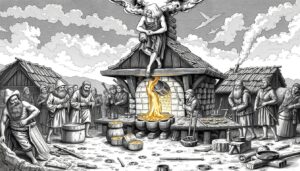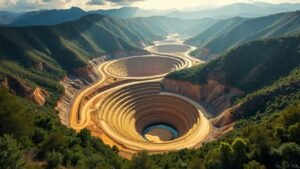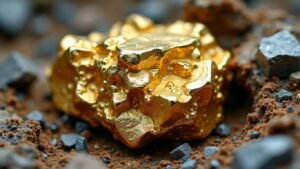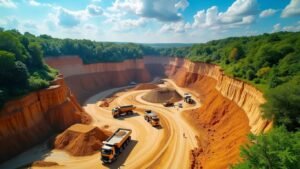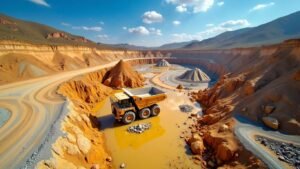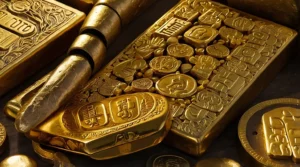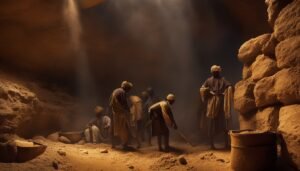When you purchase a service or a product through our links, we sometimes earn a commission, at no extra cost to you.
What secrets are hidden in the earth’s crust?
The history of gold mining goes back thousands of years. Ancient people used gold for many things, like decorating tombs and making coins. Gold was seen as a symbol of wealth and strength.
But how did they find and get this valuable metal? Let’s explore ancient gold mining. We’ll see the old ways and tech that led to today’s mining.
Key Takeaways about Ancient Gold Mining
- The world’s oldest known underground mine, located in Swaziland, dates back over 40,000 years.
- Ancient civilizations, such as the Egyptians, Greeks, and Mesopotamians, prized gold for its visual appeal, durability, and versatile applications.
- Placer mining, which exploits gold’s high density, was one of the earliest techniques used to extract the precious metal from alluvial deposits.
- Advancements in mining technology, from rocker technology to hard rock mining, have transformed the industry over time.
- The discovery of gold has played a significant role in shaping the history and development of various regions, including the founding of South Africa and the California Gold Rush.
The Origins of Gold Mining
Gold mining has been around for thousands of years. It started long ago. People back then loved gold for its beauty, stability, and many uses. They used it in art, buildings, and religious items.

Archaeological Evidence and Early Gold Artifacts
The Varna Necropolis in Bulgaria shows us gold from 4700 to 4200 BC. These finds include over 6 kilograms of gold. This tells us gold mining is at least 6,724 years old.
The Sakdrisi site in Georgia is even older, from the 3rd or 4th millennium BC. It might be the oldest gold mine found.
The Significance of Gold in Ancient Cultures
In ancient times, gold was very important in Mesopotamia, Egypt, and South America. They saw gold as a symbol of the sun and the divine. It was used in jewelry, buildings, and more.
Gold meant power, wealth, and a spiritual link in these cultures. It was a big deal.
| Ancient Civilization | Significance of Gold |
|---|---|
| Ancient Egypt | Gold was used in funerary masks, jewelry, and religious artifacts, signifying the sun god Ra and the divine. |
| Ancient Mesopotamia | Gold was highly prized and used in temples, palaces, and personal adornments, reflecting the wealth and status of the ruling class. |
| Inca Empire | Gold was revered as the “sweat of the sun” and was used extensively in religious ceremonies and royal regalia. |
Gold’s lasting charm and importance in ancient times helped start prehistoric gold mining. This practice has shaped human history for thousands of years.
Ancient Gold Mining in Egypt
The ancient Egyptians were among the first to mine gold on a big scale. They started using gold as early as the predynastic period, around 3100 BCE. They first got gold from the Nile and Nubian regions. Later, the Eastern Desert became a key place for gold during the Bronze Age.
Alluvial Mining Along the Nile and Nubia
The Nile River and its rivers in Nubia were full of ancient Egyptian gold mining opportunities. The Egyptians used simple ways to get gold from the rivers. They changed the river’s flow to get to the gold in the sediments. Then, they used simple tools to separate the gold from the sand and gravel.
It’s thought that about 250 gold mining sites were found in the Eastern Desert of Egypt over time. In the 1960s and 1970s, experts found old mining sites. They found stone mills, old settlements, and mine-shafts where gold was found.
Underground Mining and Precious Metal Refining
As time went on, the Egyptians got better at mining gold. They started using underground shafts and tunnels to find gold in quartz veins. They also came up with fire assaying to check how pure the gold was. This was a big step towards how we check gold today.
Gold was very valuable in Pharaonic Egypt. A Mesopotamian leader said gold was as common as sand on the roads around 1340 BCE. This shows how much gold they mined and refined.
“The wealth of gold in Pharaonic Egypt was legendary, as mentioned when a Mesopotamian Mitanni ruler expressed that ‘gold occurs in Egypt like sand on the roads,’ around 1340 BCE.”
Gold Mining in Ancient Greece and Asia Minor
Ancient Greece and Asia Minor were key places for gold mining and use. Archaeologists have found many ancient Greek gold artifacts. These show how advanced the gold industry was in these areas by the third millennium BC.
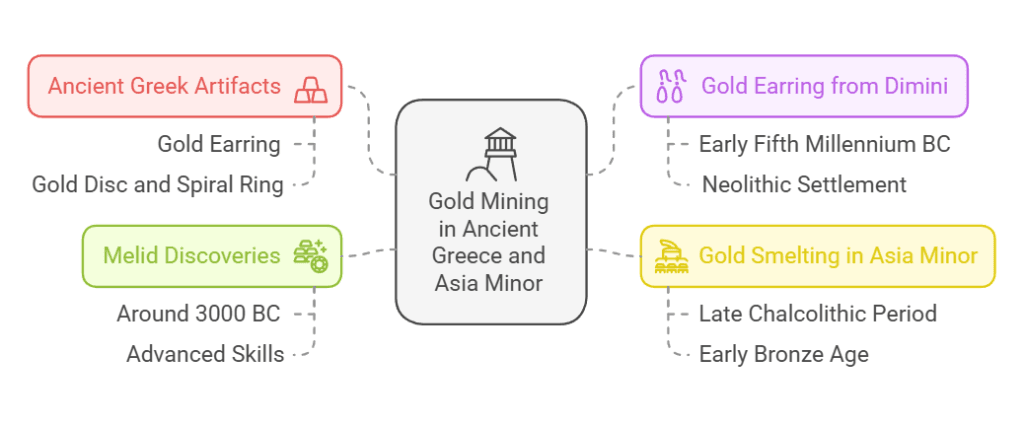
One early find is a gold earring from the Neolithic settlement of Dimini in Greece. It dates back to the early fifth millennium BC. In Asia Minor, gold smelting and production started in the Late Chalcolithic and Early Bronze Age. The city of Melid (or Arslantepe) found a gold disc and spiral ring from around 3000 BC.
These discoveries show that a strong gold mining industry was up and running in these areas long ago. They highlight the advanced skills of the people in these regions. They could mine, refine, and make gold into beautiful pieces.
Ancient Greek Gold Mining and Trade
Ancient Greek Gold Mining and TradeAncient Greek culture valued gold and silver extensively, using them for coinage and other precious items. The mining and trade of these metals played a crucial role in shaping the economic and cultural landscape of ancient Greece.
Silver Mining
The silver mines of Lavrion in Attica were exceptionally productive, with thousands of miners working there in the fifth century BC. These mines employed between 10,000 to 30,000 workers and were a cornerstone of Athens’ economy. The exploitation of silver ores in this region began as early as the 15th century BC but reached its peak between the 7th and 5th centuries BC.
Gold Sources
While Greece itself wasn’t rich in gold deposits, the ancient Greeks obtained gold from various sources:
- The island of Thasos was known for its gold mines.
- The region of Macedonia was another significant source.
- Greeks also exploited gold deposits in Thrace and along the River Hebros.
Other Valuable Metals
The island of Seriphos was rich in iron, making it more valuable than some other islands. This wealth, along with gold and silver, contributed significantly to ancient Greece’s economic and cultural growth.
Mining Techniques and Innovations
Greeks developed sophisticated mining techniques, including:
- Underground mining methods with extensive networks of shafts and adits.
- Drainage systems using adits, water wheels, and Archimedean screws.
- Ventilation and lighting technologies for deep mines.
Economic and Cultural Impact
The wealth generated from mining, especially gold and silver:
- Funded Athens’ military and cultural endeavors.
- Facilitated the introduction of coinage in the 7th century BC, marking a shift to a monetary economy.
- Financed the construction of temples, public buildings, and works of art.
Trade Networks
The scarcity of certain metals in Greece led to extensive trade networks:
- Tin, essential for bronze production, was imported from as far as Britain.
- These trade routes contributed to cultural exchange and the spread of Greek influence throughout the Mediterranean and beyond.
This comprehensive view of Ancient Greek mining and trade in precious metals underscores its significance in shaping the economic, technological, and cultural aspects of ancient Greek civilization.
Gold Mining in Asia Minor
In Asia Minor, the Lydian Empire in today’s Turkey started using standardized metal weights and the first true coins around 640 B.C. They refined gold using salt and high furnace temperatures. This shows their advanced skills in metallurgy.
The city of Melid (or Arslantepe) in Asia Minor found amazing gold artifacts like a disc and spiral ring from around 3000 BC. These items show that a complex gold mining and production industry was already there in the early Bronze Age.
The rich gold resources and mining in ancient Greece and Asia Minor were key to their growth. The ancient gold artifacts we’ve found give us a peek into the creativity and skill of their people. They lived during important times in history.
Ancient Gold Deposits and Trade Routes
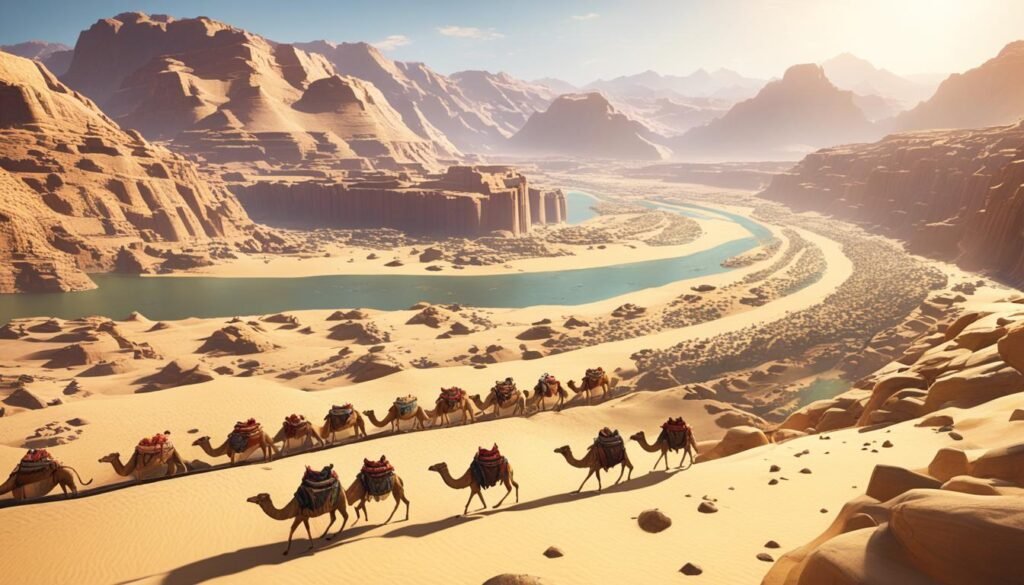
Ancient people in the Middle East and North Africa found a lot of ancient gold deposits. These deposits helped them mine and trade gold. The area near the Red Sea and the Nubian Desert was key for the Egyptian Pharaohs. They used the Nile River to move the gold.
When they couldn’t get enough gold locally, they looked to southern Africa for more. This showed how important gold was to them.
Mesopotamian and Palestinian craftsmen got their gold from Egypt and Arabia. The Mahd Adh Dhahab mine in Saudi Arabia was a big gold, silver, and copper source in the 10th century BC. This mine helped shape the historical gold trade routes of the ancient world.
Major Gold Sources in the Middle East and North Africa
- The Nubian Desert in Egypt was a big gold source for the pharaohs.
- The Mahd Adh Dhahab mine in Saudi Arabia gave a lot of gold, silver, and copper during King Solomon’s time.
- West Africa, especially the Ghana Empire, was a top gold producer in the Middle Ages. Gold was found in Ghiyaru, Galam, and Bure, and Bambuk.
- The Mali Empire found new goldfields in Burkina Faso and Ghana. This increased gold production and trade.
- The Akan people in West Africa, mainly in Ghana, started mining gold around the 11th century CE. Women were key in finding gold in the rivers.
| Region | Significant Gold Sources | Historical Significance |
|---|---|---|
| Egypt and Nubia | Nubian Desert | Provided gold for the Egyptian pharaohs |
| Saudi Arabia | Mahd Adh Dhahab mine | Major source of gold, silver, and copper during King Solomon’s reign |
| West Africa | Ghana and Mali Empires, Akan goldfields | One of the world’s greatest producers of gold in the Middle Ages |
“Gold was seen with supernatural or magical powers in certain societies, influencing its value and significance regionally.”
Ancient Gold Mining in the Americas
The Aztecs and Incas loved gold a lot. They saw it as a way to talk to the gods. This metal was very important to them.
Gold was found easily in rivers and on the surface. This made mining simple. By the second millennium BC, people in the Andes used gold. It spread north, reaching Central America and Mexico by the first millennium AD.
Pre-Columbian Gold Extraction and Metallurgy
The Aztecs and Incas were great at making gold jewelry. They made fancy headdresses and collars. These showed who was important.
Gold was only for the emperor and the nobles. In the Andes, gold was used in rituals and for important events. Most gold found later was turned into bars for easy carrying and trading.
| Pre-Columbian Gold Facts | Details |
|---|---|
| First Exploitation | Gold was first exploited in the ancient Americas by the second millennium B.C. |
| Spread of Goldworking | Goldworking gradually spread north from the Andes, reaching Central America by the first centuries A.D. and arriving in central Mexico before the end of the first millennium A.D. |
| Metalworking Mastery | Metalworking in central Mexico was quickly mastered, with Mixtec and Aztec gold-working traditions being highly regarded. |
| Sumptuary Laws | In the ancient Americas, sumptuary laws controlled gold ownership, limiting it to individuals bestowed with the privilege by the emperor, such as members of the royal family and nobility. |
| Gold Ornaments | Most ornaments made of gold in the ancient Americas were worn on or near the head for prominence and identity assertion. |
| Gold Vessels in the Andes | In the Andes, elaborate gold vessels became prominent in rituals and statecraft in the latter half of the first millennium A.D. |
| Fate of Pre-Columbian Gold | The majority of pre-Columbian gold objects discovered in the 16th century were melted down into ingots for ease of transport and trade. |
The Spanish conquest in the 16th century caused a lot of harm. Many died from forced labor and diseases. It took until the late 19th century for people to value ancient American gold for its beauty, not just its worth.
Ancient Gold Mining: Techniques and History Revealed
The history of ancient gold mining techniques shows how people got gold over thousands of years. They went from picking up gold in rivers to digging deep and refining it. This shows how ancient people pushed the limits of what they could do with the history of gold extraction.
Gold was very important to ancient people. They valued it for its beauty, its meaning, and its worth. This made them keep improving how they mined and worked with gold. These changes helped create the gold mining and processing we use now.
Alluvial Gold Mining and Early Techniques
One of the first ways to mine gold was by taking it from rivers and streams. This method, called alluvial mining, started around 3000 BC in places like western Turkey. In Sardis, Turkey, gold mining began about 700 BC.
- Gold mining in western Turkey dates back to around 3000 BC.
- Sardis, an ancient city in Turkey, has been mining gold since about 700 BC.
- Turkey produced 25 tons of gold from mines in 2011, showing its long gold mining history.
Advancements in Underground Mining and Metallurgy
As people got better at making tools, they started mining gold deeper and refining it better. This was because they wanted more gold and had used up the easy-to-get gold. This change helped them find gold deeper and make better gold products.
“The significance of gold in these ancient societies, whether for its visual appeal, cultural symbolism, or economic value, drove the ongoing evolution of gold mining and metallurgical practices.”
The ancient Greeks and Anatolians were great at mining and refining metals like gold. They dug deep and made better gold products. This made it easier to get gold and make it into something valuable.
Gold mining got even better over time. The Romans and medieval Europeans made mining and working with gold even more advanced. These changes helped create the gold mining industry we have today.
The Roman Empire and Gold Mining
The Roman Empire was a big name in ancient gold mining. They used slave labor and advanced methods like hydraulic mining. This helped them get gold from big areas in their territories.
At the Las Medulas site in Spain, we see how skilled they were in mining gold. It shows their engineering skills and how they found gold.
Hydraulic Mining and Ground Sluicing Methods
The Romans used water power to get gold from dirt. This method is called “hushing.” They built canals and reservoirs at Las Medulas to help with this.
They moved a huge amount of soil and made over 500 miles of canals. This shows how big their mining was.
They also used ground sluicing to get gold. They changed streams to wash away rocks and find gold. This was done with shaft sinking, a risky way to get to gold underground.
Even with lots of workers, they only got about 10,000 pounds of gold from Las Medulas. This was because the place was hard to reach and the mining was huge.
The Romans also mined gold in Britain and Dacia (now Romania). They had rules for mining and punished those who broke them.
As the Roman Empire grew, it found a lot of gold in the Iberian Peninsula. Getting all of Hispania meant more gold for the empire.
Medieval Gold Rushes in Europe
In the Middle Ages, Europe saw many gold rushes in different places. These events changed the economy and society of the continent. Miners used various methods to get gold from the ground.

Transylvania: Underground Mining and Alluvial Deposits
In Transylvania, miners used both surface and underground methods to find gold. They panned for gold in rivers and dug into gold-bearing ore. This made Transylvania a big gold producer, drawing workers from all over Europe.
Scotland’s 16th and 17th Century Gold Rush
The Scottish Highlands had a gold rush in the 16th and 17th centuries. Prospectors came to the region for the gold. Though smaller than others, it still changed the local economy and society.
The 19th Century Gold Rush in Wales
In the 19th century, Wales had its own gold rush. The Dolgellau area became a mining center. Welsh gold was known for its quality and was even used in royal jewelry.
Gold rushes in Europe, from Transylvania to Scotland and Wales, show our long quest for hidden wealth. These events and their methods still interest scholars and the public today.
The Renaissance and De Re Metallica
The Renaissance was a time of big changes in mining. This was thanks to Georgius Agricola’s book, “De Re Metallica,” in 1556. It covered mining from start to finish, making Agricola a key figure in mining.
Georgius Agricola’s Groundbreaking Work on Mining
“De Re Metallica” was a top mining guide for 180 years after it came out. It had 292 woodcut pictures and showed the mining tech of the 1500s. This book was full of details on mining machines and methods.
Agricola used old knowledge from authors like Pliny the Elder and Theophrastus. He also brought new ideas that changed mining for years to come. He talked about finding and mining ores, showing the need for special skills.
“De Re Metallica” was big on the idea of miners needing special education. It covered many subjects like philosophy, medicine, and law. Agricola saw mining as a key job that helped with building and farming.
The first English version of “De Re Metallica” came out in 1912. Herbert Hoover, a mining engineer and later U.S. President, and his wife Lou Henry Hoover, a geologist, translated it. Their work spread Agricola’s important ideas to more people.
“De Re Metallica” was a key book in mining and metallurgy for 180 years. It showed how important Agricola was in the field.
Early Modern Gold Mining Techniques
In the early modern era, gold mining changed a lot. New methods made getting gold faster and more efficient. The use of mercury in the amalgamation process was a big step forward.
Amalgamation and Mercury-Based Extraction
The amalgamation process changed gold mining a lot. It crushed the ore into dust, then added mercury. When heated, the mercury turned into vapor, leaving pure gold behind.
This method got better with the addition of water, salt, iron filings, and copper sulfate. It made getting gold much easier.
But, using mercury was bad for the environment and people’s health. This problem still affects small-scale gold mining today. The early use of mercury led to better, safer mining methods later on.
The amalgamation process was a big leap in mining. Yet, it showed the need for safer mining ways. Today, finding ways to mine without mercury is key. The goal is to protect the environment and keep miners safe while still mining gold.
Environmental Impacts of Ancient Gold Mining
Ancient gold mining has had a big impact on the environment. Problems like mercury pollution, mining waste, and deforestation are big concerns. Mercury was often used in mining, which polluted water and harmed humans and animals.
Also, mining damaged the land by digging up large areas and making tailings ponds. These problems still affect today’s small-scale gold mining.
It takes a lot of waste to make just one wedding ring. Mining dumps 180 million tonnes of toxic waste in water each year. There have been 221 major failures of tailings dams.
In the U.S., mining was the top polluter in 2010. It released 1.5 billion pounds of chemical waste. This included arsenic, mercury, and lead.
- The heap leaching method used in gold mining creates a lot of waste. Only about 0.01% of it is gold.
- The Pebble Mine in Alaska could dump over 3 billion tons of waste.
- Most mining happens near areas of high conservation value. In Ghana, mining has left less than 11% of the original forest.
Ancient and modern gold mining have caused huge environmental damage. We need mining that is sustainable and cares for the environment and local communities.
“The environmental impact of ancient gold mining practices has been significant, with issues such as mercury pollution, the disposal of mining waste and tailings, landscape destruction, and deforestation being major concerns.”
Small-Scale Alluvial Gold Mining and Mercury-Free Alternatives
Traditional gold mining has raised big environmental concerns. Now, new ways to mine gold are being used. In Colombia, some miners use a mercury-free method. They use plants like Balso and Malva to make a frothy liquid for gold panning. This method cuts down on mercury and still lets miners work.
The mining world is changing, and finding ways to mine without harming the planet is key. The Amazon rainforest, which is 30% of the world’s mercury sink, faces deforestation. This leads to more mercury in the air and makes it hard for the forest to clean itself. Deforestation in the Amazon adds about 10% of the 2,000 tons of mercury released yearly.
Mercury has been used in mining since the Spanish times in South America. Peru, a big gold producer, says about 20% of its gold comes from the Amazon. This gold mining puts 185 tons of mercury into water each year. Studies show many people, especially kids, in Madre de Dios have high mercury levels.
Looking for environmental-friendly mining techniques is important. Using mercury-free gold extraction methods, like plant-based froths, is a good step. It helps reduce the bad effects of old mining ways.
“It is estimated that gold extraction releases around 185 tons of mercury directly into waterways in the Peruvian Amazon every year.”
The Evolution of Gold Mining Technology
Gold mining has changed a lot over time. From old ways to today’s advanced methods, it’s seen a big change. Miners have found better ways to find, get, and clean gold. They’ve made progress in prospecting, drilling, processing, and managing waste.
From Ancient Times to the Modern Era
Long ago, miners used simple tools and hard work to get gold. But as gold was needed more and tech got better, mining changed a lot.
The California Gold Rush of 1849 was a big turning point. Miners came up with new ways like hydraulic mining. This method used water jets to wash away hills for gold. But it hurt the environment a lot, so it was later banned.
Now, mining is more careful and smart. Modern mining uses advanced tech like robots, drones, and smart sensors. These tools make mining faster, safer, and less harmful to the planet.
Getting gold has always been a big deal, pushing for better ways to do it. From ancient tools to today’s tech, mining shows our creativity and strength.
“The history of gold mining is a story of technological innovation, driven by the relentless pursuit of this precious resource. As we look to the future, the industry continues to evolve, harnessing the power of cutting-edge technologies to extract gold in a more sustainable and responsible manner.”
Conclusion
The history of gold mining is long and interesting. It goes back thousands of years to when early people found gold in rivers. Today, we use advanced methods to get gold.
Gold mining has changed a lot over time. It started with ancient cultures seeing gold as very important. Then, new technologies made getting gold easier and safer.
Now, we face new challenges like protecting the environment. Despite this, gold mining is still big worldwide. Countries like China, Russia, and Australia lead in gold production.
Looking ahead, gold mining will focus on being more sustainable. It will use new technologies to lessen harm to the environment. This way, the industry will keep up with the world’s need for gold.
Frequently Asked Questions
Why is understanding ancient gold mining important?
Understanding ancient gold mining provides a crucial perspective on the foundation of the modern gold market, highlighting technological innovation, the evolution of gold extraction technology, and its role in building empires.
What techniques did ancient gold miners use to find and extract gold?
Ancient miners relied on observation and techniques like placer mining (panning, sluicing, ground sluicing) to find gold in riverbeds based on its density. They also developed underground mining with shafts and tunnels, fire-setting to break rock, hydraulic mining, and later, techniques like amalgamation for extraction and cupellation for refining.
Which ancient civilizations were known for large-scale gold mining?
Major players in ancient gold mining included the Egyptians, Greeks, Romans (known for hydraulic mining and slave labor), Lydians, Aztecs, and Incas.
Did ancient gold mining have negative environmental effects?
Yes, ancient gold mining caused environmental damage, including mercury pollution (from amalgamation), landscape destruction, deforestation, and the creation of large amounts of mining waste.
What was the significance of gold beyond simple decoration in ancient cultures?
Beyond jewelry, gold represented power and wealth, fueled empires, drove trade, and held religious significance. It was used in temples, palaces, royal regalia, rituals, statecraft, and sometimes seen as having supernatural or magical powers.
How did Georgius Agricola's "De Re Metallica" influence mining?
"De Re Metallica," published in 1556, served as the standard mining manual for centuries. It meticulously detailed mining processes with illustrations, standardized knowledge, elevated mining to a respected profession, and covered various aspects from finding ore to refining.
What are some sustainable alternatives to traditional gold mining methods today?
Modern sustainable approaches include using plant extracts for panning, bioleaching with microorganisms, improving tailings management, and recovering gold from electronic waste to promote a circular economy and reduce environmental impact.
Related Blog Posts
Gold Mining in Ancient Africa: Quick Facts
Discover how gold mining in ancient Africa shaped history, using simple tools and methods that still…
Read MoreAncient Gold Smelting Process in Europe – Historical Methods
Discover how ancient civilizations mastered the ancient gold smelting process in Europe through trad…
Read MoreExploring the Riches: The Untold Story of Mexican Gold Mines and Their Impact on the Economy
Uncover the untold story of Mexican gold mines and their profound impact on the economy and culture.
Read MoreUnlocking the Secrets of Gold Ore: A Comprehensive Guide to Its Formation and Extraction
Explore gold ore's formation, extraction methods, and environmental impacts in this engaging guide.
Read MoreExploring Innovative Gold Mining Methods: A Comprehensive Guide
Discover innovative gold mining methods, from historical techniques to modern tools, and their envir…
Read MoreExploring the Depths: The Future of Gold Mining Underwater
Dive into the future of underwater gold mining, exploring tech, challenges, and the allure of hidden…
Read MoreUnearthing the Mysteries: The Journey of Gold in the Earth
Explore the captivating journey of gold, from ancient mining techniques to modern practices and envi…
Read MoreExploring the Future of Puregold Mining: Opportunities and Challenges Ahead
Discover the future of Puregold mining, exploring its opportunities, challenges, and sustainable pra…
Read MoreGold Trade and Economy in Ancient Times
Unlock the secrets of gold trade and economy in ancient times. Explore the economic impact of mining…
Read MoreGold Mining in Ancient Nubia – Unraveling its Mysteries
Gold Mining in Ancient Nubia – Unraveling its Mysteries. Explore the ancient Nubian civilization's a…
Read MoreGold Mining in Ancient China: Historical Practices Revealed
Gold mining in ancient China is truly fascinating. Chinese miners from early dynasties were skilled …
Read MoreGold Mining in the Ancient British Isles: Historical Insights
Did you know that gold mining, copper mines, and prehistoric metalworking in the ancient British Isl…
Read MoreSource Links
- https://en.wikipedia.org/wiki/Gold_mining
- https://www.nma.org/pdf/gold/gold_history.pdf
- https://geology.com/usgs/gold/
- https://www.britannica.com/technology/gold-processing
- https://uwaterloo.ca/earth-sciences-museum/resources/mining-canada/world-history-gold
- https://www.metmuseum.org/toah/hd/egold/hd_egold.htm
- https://www.tms.org/pubs/journals/jom/9703/meyer-9703.html
- https://www.sciencedirect.com/science/article/abs/pii/S089953620100094X
- https://goldgold.com/gold-in-the-ancient-world.html
- https://www.worldhistory.org/gold/
- https://depositsmag.com/2016/07/14/mining-in-ancient-greece-and-rome/
- https://www.worldhistory.org/article/1383/the-gold-trade-of-ancient–medieval-west-africa/
- https://study.com/academy/lesson/ancient-gold-mines-in-africa.html
- https://www.sciencedaily.com/releases/2015/06/150605081611.htm
- https://www.metmuseum.org/toah/hd/gdaa/hd_gdaa.htm
- https://www.xtb.com/en/education/the-history-of-gold-mining
- https://www.sierragoldparksfoundation.org/page/history-of-empire-mine/
- https://www.scirp.org/journal/paperinformation?paperid=73830
- https://www.mininghistoryassociation.org/Journal/MHJ-v3-1996-Economopoulos.pdf
- https://www.americanscientist.org/article/the-origin-of-gold-in-south-africa
- https://en.wikipedia.org/wiki/Mining_in_ancient_Rome
- https://english.elpais.com/culture/2023-01-07/this-is-how-the-romans-squeezed-the-gold.html
- https://academic.oup.com/book/5195/chapter/147856204
- https://en.wikipedia.org/wiki/Gold_rush
- https://academic.oup.com/book/5350/chapter/148133484
- https://www.history.ox.ac.uk/article/how-gold-rushes-helped-make-modern-world
- https://en.wikipedia.org/wiki/De_re_metallica
- http://www.tms.org/pubs/Books/PDFs/09-1001-e/09-1001-0.pdf
- http://www.goldfieldsguide.com.au/blog/61/the-wizard-miners-of-the-16th-century-de-re-metallica

